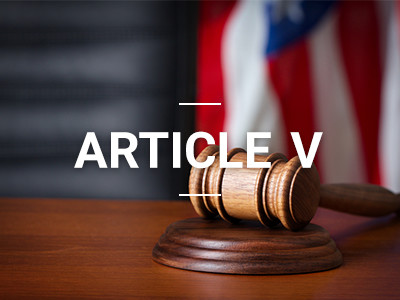To listen to an audio of this article, please click here.
Advocates of the long-dead Equal Rights Amendment (ERA) have lost an effort to get their amendment “certified” by the Archivist of the United States.
On Feb. 28, 2023, the United States Court of Appeals for the District of Columbia denied a request from two states for a “writ of mandamus” (a kind of order) to force the Archivist to certify the ERA. The court—often referred to as the “D.C. Circuit”—is widely considered to be the second-most-important court in the land. The name of the case was Illinois v. Ferriero (pdf).
From the standpoint of constitutional amendment law, the ruling is correct, but the process that led to it was unnecessarily convoluted. You get the impression that neither the judges nor the parties had a good grasp of Article V principles.
The ERA
The ERA was a constitutional amendment proposed by Congress in 1972. Congress made the proposal subject to a seven-year ratification deadline. The ERA was billed as a measure to ensure equal rights for women.
Initial public reception for the ERA was enthusiastic. Thirty-five state legislatures ratified it, out of the necessary 38. Then doubts began to set in. The measure was not well drafted, and people began to wonder what, if anything, it would do beyond the existing provisions of the Fourteenth Amendment’s Equal Protection Clause. Many saw it as a potentially huge transfer of power away from the people’s elected representatives and to the courts.
After the number of ratifications topped out at 35, some states began to repeal their ratifications. When the seven-year deadline passed, Congress purported to extend it to 1982—but by only majority votes of each House instead of the required two thirds. There were no more ratifications during the extended period, and a federal court subsequently ruled the time extension invalid anyway. Justice Ruth Bader Ginsburg, a key ERA supporter, acknowledged that the amendment was dead.
The Lawsuit
Nevertheless, political activists have been fundraising with the stated goal of reviving the ERA. They convinced the state legislatures of Nevada, Illinois, and Virginia to “ratify” the expired amendment. They then convinced the Nevada and Illinois attorneys general to sue to get the U.S. Archivist to certify the ERA.
Unfortunately, constitutional amendment law is neglected in the nation’s law schools. The resulting ignorance helped feed litigation that was a waste of donors’ money and judicial resources.
The legal argument for the ERA was as follows:
- only state ratifications should be counted; rescissions should not be;
- Congress has no authority to impose a deadline on ratification;
- even if a deadline is valid, it must be in the body of the amendment and not in an introductory paragraph; and
- the Archivist has power to determine whether an amendment is adopted, and should be required to so determine.
To a person familiar with amendment law, these positions are absurd.
Some Principles of Amendment Law
The pro-ERA arguments disregarded a central tenet of amendment law: The rules that legislatures and conventions follow in the amendment process are the same as for any other procedure—unless the Constitution says differently or the particular assembly decides differently.
For example, the Constitution requires a two-thirds majority of each House for Congress to propose a constitutional amendment, but otherwise the voting and quorum requirements are the same as for any other resolution.
Moreover, each assembly is the master of its own resolutions. When Congress or a convention propose an amendment, it may insert a deadline—just as for any other resolution. And until the Constitution’s stated threshold is met (two-thirds for applications, three fourths for ratifications) state legislatures may time-limit applications and ratifications or rescind them, just as they may for other resolutions.
Indeed, the U.S. Supreme Court has stated explicitly that Congress may impose deadlines on its proposed amendments. True, the court initially said that imposing deadlines was an incident of Congress’s power to designate a “Mode of Ratification.” But later cases have hinted at the truth: a ratification deadline is merely a component of the proposal itself.
Moreover, the Constitution imposes no special written format that Congress, state legislatures, or conventions must follow in proposing, ratifying, applying, or rescinding. Each assembly may adopt its own format.
Also violating a central tenet of amendment law was the ERA-supporters’ claim that the Archivist has, under a congressional statute, power to determine an amendment’s validity. In fact, statutes are not binding in the Article V procedure. Congress may not confer on the Archivist or anyone else the final say about whether an amendment has been ratified. The final decisions on validity are made by the courts, according to their understanding of the Constitution’s terms.
The court’s opinion in Illinois v. Ferriero mentioned that the Supreme Court had said Congress may impose a ratification deadline. Otherwise, neither the judges nor the parties in the case seemed to understand any of the basic principles of amendment law just listed. Instead, the D.C. Circuit used the technicalities of “mandamus” law to dismiss the case.
I’ve explained the principles above in my treatise, The Law of Article V.








